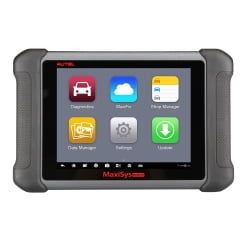Launch CRP129 OBD2 Scanner Car Diagnostic Scan Tool ENG/AT/ABS/SRS EPB SAS OIL Service Light Resets Code Reader for Mechanic and Experienced Enthusiast
★COMPREHENSIVE SCAN TOOL★ Featuring reading/clearing codes and viewing live data for four important systems (engine/transmission/ABS/SRS) and special reset functions (Oil Reset, EPB/SAS Reset), this scan tool is a great choice for mechanics to facilitate their diagnostic analysis★WIDE VEHICLE COVERAGE★ LAUNCH CRP129 code reader works on over 40 OBD2 complaint vehicles after 2006, and the diesel models of 12 Voltage. You may consult us about the coverage via Q&A/Email before purchase, leaving out unnecessary time and troubles★FULL OBD2 FUNCTIONS★ To most car owners, an obd2 scanner’s ability to read codes and do smog tests is what matters. This launch OBD2 scanner supports full OBD2 tests including I/M readiness and O2 sensor tests etc., that will keep your mind from worrying about emission checks★USER-FRIENDLY DESIGNS★LAUNCH CReader CRP129 is 7.4 inches long and 4.4 inches high, enabling it to be easily operated and stored. It displays data clearly with TFT LCD screen and responses within seconds, making diagnostic work smooth, simple and fast★WARRANTY & UPGRADE★The diagnostic tool provides 12-month warranty from the date of purchase and lifetime free online upgrade. Notice: The upgrade can be finished with Window-based computer ONLY. The “Password”, i.e. register code, can be found in “help” application★The reason to choose scan tool LAUNCH CRP129★Diagnoses of 4 systems – Engine, Transmission, ABS, Airbag (SRS)Reset functions – oil reset, EPB reset and SAS resetMultiple car models (covering over 40 prevailing models from Asia, America and Europe)Support all 10 test modes of the OBDIIRead DTC & Clear DTCDisplay DTC help information and service informationOxygen sensor test, carbon canister testDynamic data stream graphic displaySupport lifetime free online upgradeSupoort diagnostic report printingMultiple languages support: English French German Spanish Portuguese Russian Japanese Italian★Real-time DataStream Analysis★The LAUNCH CRP129 scanner can read data streaming for OBDII/ ENG / AT / ABS /SRS (Airbag), which shows the specific four systems live data readiness and allows you to analyze the real-time data stream via a waveform display, for quickly and accuratelydiagnostics.★Lifetime Free Online Update★Not just featuring riches of easy-to-use diagnostic functions, the CRP129 scanner also gets access to free software updates via the internet-connected PC with multilingual support. You’re able to update the diagnostic software on your Windows or Macwith a TF card.★DTC Lookup and Recording Data Function★DTC Lookup: Built-in DTC lookup library, Retrieves generic (P0, P2, P3, and U0) and manufacturer specific (P1, P3, and U1) code, show definitionsRecording Data Function: Review or delete the recorded DTC, data streams, and freeze frame. You can check it on device diagnosis menu the “Review” part to check.
















Reviews
There are no reviews yet.